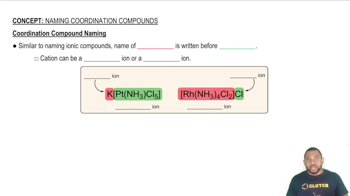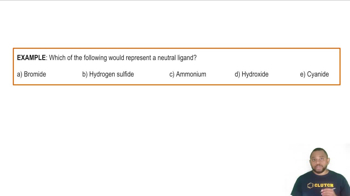Here are the essential concepts you must grasp in order to answer the question correctly.
Coordination Compounds
Coordination compounds consist of a central metal atom or ion bonded to surrounding molecules or ions, known as ligands. In this case, Ru (Ruthenium) is the central metal, and it is coordinated with five chloride ions and one water molecule. Understanding the nature of these interactions is crucial for sketching the correct structure.
Recommended video:
Coordination Compound Naming
Ligands
Ligands are ions or molecules that can donate a pair of electrons to a metal center in a coordination complex. They can be classified as monodentate (binding through one atom) or polydentate (binding through multiple atoms). In the given compound, water acts as a monodentate ligand, while chloride ions can also be considered monodentate ligands.
Recommended video:
Oxidation States
The oxidation state of a metal in a coordination compound indicates its charge and is essential for understanding the compound's reactivity and properties. In Na2[Ru(H2O)Cl5], the oxidation state of Ru can be determined by considering the charges of the ligands and the overall charge of the complex, which is neutral. This understanding is vital for accurately naming the compound.
Recommended video:

 Verified step by step guidance
Verified step by step guidance


